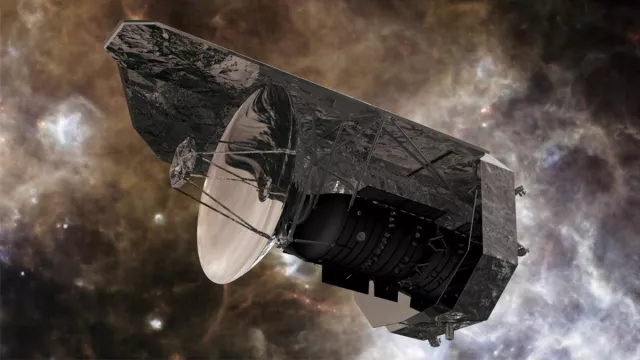For four years, ESA’s Herschel space telescope launched in 2009 surveyed the coldest objects in the Universe to gain new insights into star and galaxy formation, as well as analysing the atmospheric chemistry of planets and comet tails.
Key information
| Mission | Study of galaxy and star formation, and of the molecular chemistry of planets, comets and atmospheres |
|---|---|
| Domain | Science |
| Launch date | May 2009 |
| Partners | ESA, IRAP (ex-CESR), CEA/IRFU (ex-DAPNIA), CEA/LETI, CEA/Dap (ex-Sap), CEA/DSBT (ex-SBT), CNRS, LAM, OASU (ex-Bordeaux Observatory), IAP, OHP (ex-OAMP), LESIA |
| Where | In orbit around the L2 Lagrange point (1.5 million km beyond Earth’s orbit) |
| Lifetime | Initially scheduled for three years, ended in April 2013 |
| Status | Completed |
Key figures
- 55 to 672 µm: wavelength range of observed light
- 3 instruments
- 3,402 kg: telescope mass
- 11 contributing French laboratories and institutes
Key milestones
- 23 April 2013: Helium coolant depleted, bringing mission to an end
- 15 July 2009: Herschel arrives at Earth-Sun L2 Lagrange point
- 14 May 2009: Herschel launched by Ariane 5-ECA
- January 2008: Start of environmental testing
- January 2008: Flight model delivered to ESTEC
- 2001: Work starts on construction of telescope
- 2000: FIRST renamed Herschel
- 1992: Industrial study kicks off
- 1986: FIRST selected as ESA cornerstone mission
- 1982: ESA proposes FIRST project (Far InfraRed and Sub-millimetre Telescope)
Project in brief
For four years, the Herschel space telescope accomplished the amazing feat of observing objects that radiate at temperatures of between –268°C and –223°C, too cold to emit visible light, until it ran out of coolant at the end of April 2013, bringing its mission to an end. Launched in 2009 by the European Space Agency (ESA), Herschel’s mission was to conduct observations of very cold objects emitting at far-infrared and submillimetre wavelengths (55 to 672 µm), a range of the spectrum that cannot be explored from Earth, in order to study the formation of stars and galaxies and to analyse the chemical composition of atmospheres of planets in our solar system, comets and the interstellar medium. To do this, Herschel had three very-low-temperature instruments: SPIRE (Spectral and Photometric Imaging Receiver), HIFI (Heterodyne Instrument for the Far Infrared) and PACS (Photodetector Array Camera and Spectrometer). It also carried a 3.5-metre-diameter primary mirror, larger than on any previous space telescope.
CNES’s role
Herschel is the fourth cornerstone mission of ESA’s mandatory scientific programme. CNES oversaw and funded French research laboratories’ participation in the mission. This participation was significant, as the French atomic energy and alternative energies commission CEA, the LAM astrophysics laboratory in Marseille, the IRM millimetre radioastronomy institute, the CESR space radiation research centre and the Bordeaux Observatory helped to build the HIFI, PACS and SPIRE instruments.
Contacts
Head of Astronomy & Astrophysics
Philippe Laudet
E-mail: philippe.laudet at cnes.fr


